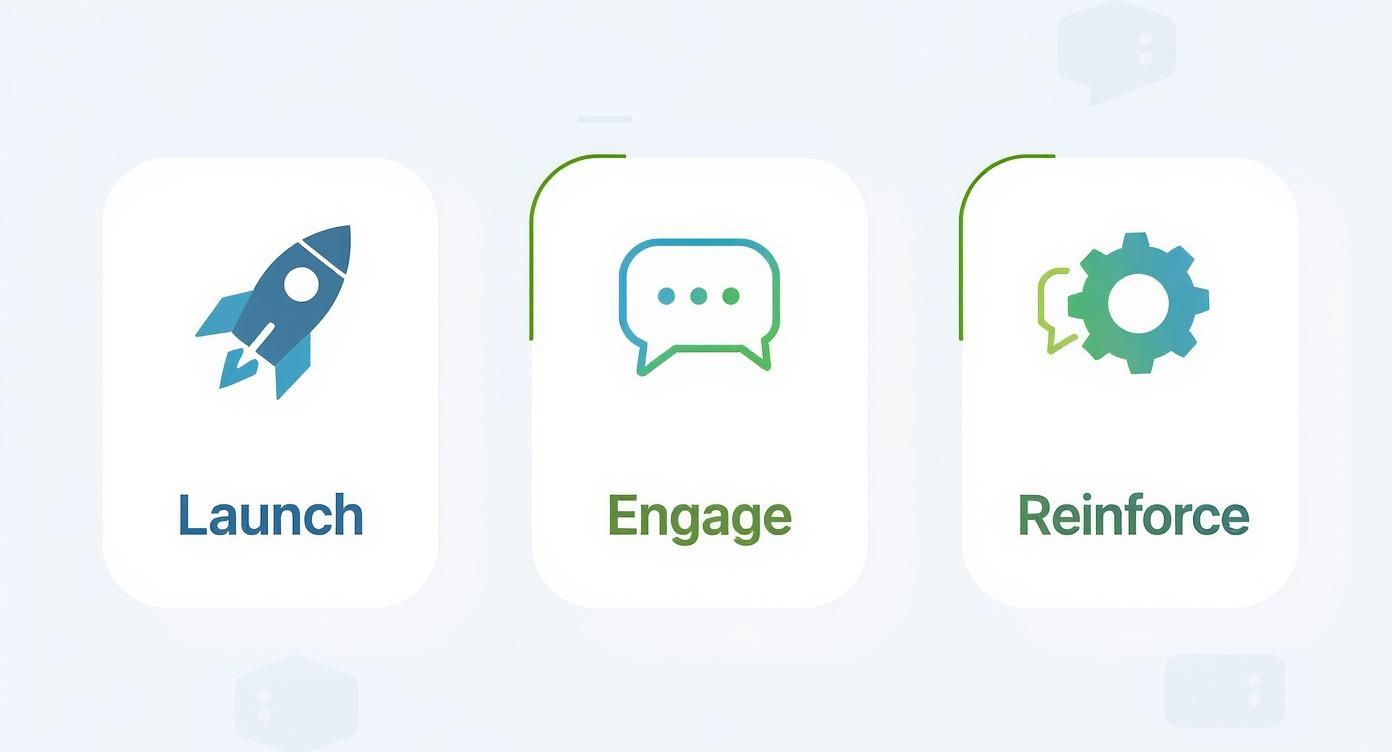Stay Updated with Everything about MDS
Thank you! Your submission has been received!
Oops! Something went wrong while submitting the form.

Chilat Doina
October 27, 2025
Team leadership development is all about intentionally building a pipeline of talent. For a fast-growing e-commerce brand, it means systematically turning your high-potential employees into confident managers who can handle whatever comes their way—from wrangling larger warehouse teams to making sharp, data-driven marketing decisions.
The e-commerce world doesn't slow down. A single Google algorithm update, a new competitor popping up, or a sudden supply chain snag can force your entire business to pivot overnight. This kind of environment is way too volatile to rely on just one or two key people to steer the ship.
To put it bluntly, leadership needs to be a distributed strength across your entire organization.
Strong leadership is directly tied to your ability to scale. We've all seen it happen: you promote a top-performing warehouse associate to shift lead without any real training. What happens? You lose a fantastic worker and gain a struggling manager. This creates a bottleneck that slows down everything from order fulfillment to inventory management.
When you don't have trained leaders, you create problems that might not show up on a balance sheet right away, but they are incredibly damaging over time. These issues pile up, making growth feel like a constant, stressful battle.
Some of the most common consequences I've seen are:
"Leadership isn't a title; it's an action and an example. In e-commerce, where every day brings a new challenge, your team's ability to act and adapt is your greatest competitive advantage."
The good news? This leadership gap is a completely solvable problem. The bad news is that it’s everywhere. Shocking research shows that while 77% of organizations admit they have a leadership gap, a staggering 58% of managers have never received any formal leadership training. You can dig into more of this eye-opening leadership development research on Exec.com.

A structured team leadership development program is what bridges the gap between an employee's raw potential and their actual on-the-job performance. It’s how you formalize the process of teaching essential skills like clear communication, effective delegation, and strategic thinking.
By investing in your people, you’re not just being nice—you’re building a resilient organization that can handle the pressures of rapid expansion.
This is a non-negotiable part of the journey when you scale an e-commerce business because it ensures your operational backbone grows right alongside your sales. Instead of constantly hiring externally for every new management role, you create a sustainable system that promotes from within. This preserves your company culture and rewards the very people who helped you get there.
So, what skills should your program actually focus on? The needs of an e-commerce leader are unique. They need to be analytical, adaptable, and great with people—all at the same time.
Here are the core competencies I've found to be absolutely critical.
Essential Leadership Skills for E-Commerce Success
CompetencyWhy It Matters in E-CommerceExample ScenarioData-Driven Decision MakingE-commerce runs on data. Leaders must be able to interpret analytics (sales, marketing, operations) to make informed choices instead of guessing.A marketing lead analyzes a dip in conversion rates, identifies the cause through A/B testing data, and adjusts the campaign budget accordingly.Agile Project ManagementThe market changes fast. Leaders need to manage projects in short, flexible cycles (sprints) to launch products or campaigns quickly and adapt to feedback.A fulfillment manager implements a new packing process for a 2-week trial period to measure efficiency gains before rolling it out company-wide.Cross-Functional CommunicationMarketing, logistics, and customer service are deeply interconnected. Leaders must communicate clearly across departments to ensure everyone is aligned.The head of operations clearly communicates a shipping delay to the customer service team, equipping them with the information to manage customer expectations.Delegation & EmpowermentYou can't scale if leaders are micromanaging. They must learn to trust their team, delegate tasks effectively, and empower employees to take ownership.A warehouse manager trains a team member to handle inventory reconciliation, freeing up their own time to focus on optimizing workflow for the entire facility.Financial AcumenLeaders need to understand the financial impact of their decisions, from managing ad spend and inventory costs to understanding profit margins.A category manager proposes dropping a low-margin product line after analyzing its profitability and impact on warehouse storage costs.
Focusing your training on these specific areas ensures you're not just creating "managers" but building true e-commerce leaders who can drive real, measurable growth.
Your next great manager probably isn't an external hire you haven't met yet. They're more than likely already on your payroll, maybe handling customer service tickets or optimizing picking routes in your warehouse. The real challenge is learning how to see them.
Identifying leadership potential early is about looking beyond job titles and daily tasks. You have to spot the specific behaviors that signal someone is ready for more responsibility. This isn't about guesswork; it's about sharp observation.
Think about it: who on your team naturally steps up when things get chaotic during a flash sale? Who do others turn to for advice, even if that person isn't officially in charge? These are the raw signals of leadership.

You don’t need a complex HR department to find your next leaders. What you need is a simple framework for what to look for. The key is to focus on concrete actions, not just personalities.
Here are some tell-tale signs of leadership potential I've seen over and over in e-commerce settings:
Once you know what to look for, you can use simple, low-cost methods to confirm your gut feelings. These techniques help you move from a hunch to a more objective assessment of who is ready for a real leadership shot.
1. Analyze Performance Data for Clues
Dive into the data you already have. Sure, look for individuals who consistently exceed performance targets, but dig deeper. Look for those whose work creates a positive ripple effect. Does one customer service rep have a consistently higher satisfaction score because they take the time to document common issues for the whole team? That’s a clue.
2. Solicit Peer Feedback Informally
During your regular one-on-ones, casually ask questions like, "Who on the team do you go to when you're stuck on a problem?" or "Who is great at explaining complex processes?" You’ll start hearing the same names pop up. These are your natural mentors and influencers. Building the right team is foundational, and you can learn more about structuring your e-commerce team in our detailed guide here: https://milliondollarsellers.com/blog/ecommerce-team-structure.
3. Test with Small-Scale Projects
Give a high-potential employee a small, low-risk project that’s outside their normal duties. This could be researching new shipping software or organizing a team-building event. The goal isn't just to see if they can complete the task, but to observe how they do it. Do they create a plan? Do they involve others and communicate progress? It’s a perfect, low-stakes test of their initiative and organizational chops.
A key thing to watch for during these tests is how they handle people. When you’re trying to spot a leader, you have to assess their capacity for emotional intelligence in leadership, as this is often what separates a good manager from a truly great one.
Ultimately, spotting future leaders is the first critical step in building a strong leadership pipeline. By creating a simple, objective system to identify these driven individuals, you ensure you're investing your training resources in the people most likely to grow into the leaders your business needs. This isn't about finding the loudest person in the room; it's about finding the one who makes the entire team better.
Let's be real: a generic, off-the-shelf leadership course isn't going to cut it for the unique pressures of e-commerce. Your business deals with specific challenges that you just don't see elsewhere—managing inventory for flash sales, optimizing ad spend across a dozen platforms, and coordinating with suppliers on the other side of the world. A one-size-fits-all program simply can't prepare your emerging leaders for these realities.
The most effective team leadership development programs are built from the ground up. They're designed to solve your actual business problems, moving beyond abstract theories to focus on practical skills that will directly impact your company's performance.
So, instead of teaching "general finance," your program should teach how to analyze your own store's P&L statement. Rather than a vague module on "communication," it should zero in on how to write a crystal-clear project brief for a new product launch.
The best place to start is by looking at your biggest operational bottlenecks and skill gaps. Where are projects stalling? What recurring problems are costing you time and money? These pain points are the foundation of your curriculum.
From there, you can design modules that directly tackle these issues. The goal is a learning path that feels immediately relevant to your team's daily work.
Here are a few e-commerce-specific modules you could build out:
People learn in different ways. A program that leans too heavily on one method—like just lectures or online videos—is a recipe for boredom and poor retention.
A well-rounded approach ensures that knowledge isn't just acquired but is also practiced and reinforced in a real-world context. This blend is what turns learning into a lasting skill.
The most powerful learning happens when a new concept is immediately applied to a real problem. Your program should be less like a classroom and more like a workshop where participants actively solve challenges your business is facing right now.
Think about combining these different formats to create a dynamic learning experience.
A Mix of Effective Training Formats
MethodDescriptionE-commerce ExampleInteractive WorkshopsGroup sessions focused on hands-on activities, problem-solving, and role-playing.A workshop where participants use real sales data to build a promotional calendar for the next quarter.One-on-One MentorshipPairing emerging leaders with experienced senior staff for regular guidance and feedback.A senior marketing manager mentors a junior employee, reviewing their campaign proposals and offering strategic advice.Self-Paced LearningCurated online courses, articles, and books on specific topics that participants can complete on their own time.Assigning a course on Google Ads optimization, followed by a discussion on how to apply the learnings to current campaigns.Action Learning ProjectsAssigning participants a real business problem to solve as a group, requiring them to apply their new skills.A team is tasked with reducing customer service response times by 15% and must present their solution to management.
Finally, every module and activity needs a purpose. It should be tied to developing specific leadership competencies you've identified as critical for your business.
When designing your program, it's crucial to define the core abilities you aim to build. You can look at lists of essential leadership skills for managers as a starting point, but then you have to adapt them to your unique business needs.
This step ensures your program has a clear focus and measurable outcomes, turning high-potential employees into the confident, capable leaders your e-commerce business needs to thrive.
Right, you've got a brilliant plan on paper. Now comes the hard part: actually making it happen.
A plan is just a document until you breathe life into it. This is where your leadership development program goes from a great idea to a real, tangible thing that changes how your business operates. And trust me, a thoughtful execution makes all the difference. It's about more than just sending a calendar invite; you need to build momentum, get genuine buy-in, and create an environment where the lessons actually stick.
The launch really sets the tone for everything that follows. One of the biggest hurdles I see in e-commerce is just scheduling. You can't just pull your best people off the warehouse floor during the holiday rush. It's a recipe for disaster. Be strategic. Look for a predictable lull in your business calendar to kick things off. This ensures everyone can actually show up and be present, not feeling like they're being pulled in a million different directions.
That first session is your moment to get people genuinely excited. Please, don't just dive into a slideshow.
Start by drawing a crystal-clear line between the program's goals and the company's future. But—and this is just as important—connect it to each person's individual career path. People need to see what's in it for them.
To get real buy-in, especially from senior managers whose support is non-negotiable, you have to speak their language. Frame the launch in business terms. Explain how this investment is going to directly solve major operational headaches, like cutting down on fulfillment errors or boosting team retention rates.
A leadership program isn't an academic exercise; it's a strategic tool. The whole point is to create a measurable shift in how your teams operate, solve problems, and push the business forward. Every single part of your launch should hammer home this practical mission.
That initial buzz from a launch can die out fast if you're not careful. The secret to bridging the gap between a one-off training event and real skill development is consistent engagement. This means regular, structured check-ins are non-negotiable.
And these aren't just for holding people accountable. They are prime opportunities to talk through challenges, celebrate small wins, and connect the training material directly to real-world problems participants ran into that very week.
For example, maybe a new leader struggled with delegating a tricky task. In the check-in, they can share what happened and get immediate, practical feedback from their peers and mentors. This is the continuous feedback loop that turns theory into an actual, usable skill. We all know from research that learning retention plummets without reinforcement. By building in these touchpoints, you make sure the lessons are actually being put to work on the job.
Let me be blunt: the single most important person in making training stick is the participant's direct manager. Full stop.
If a newly trained leader goes back to their team and their boss doesn't support or model the new behaviors, you've just wasted a ton of time and money. Their managers have to be active partners in this process.
Before the program even begins, pull the managers of your participants into a separate briefing.
This partnership is what ensures learning doesn't just happen in a training room. It happens on the warehouse floor, in marketing stand-ups, and during customer service calls. It’s how you translate your program directly into better daily performance and a stronger bottom line.
So, you've invested in your people. That's great. But how do you prove it's actually paying off? Justifying a team leadership development program isn’t just about feel-good stories of personal growth; it's about connecting that growth to cold, hard business results. Stakeholders want to see a return on investment (ROI), and your ability to show them the money is what secures future budget and support.
This means we have to move beyond simple satisfaction surveys. "Did you enjoy the training?" is a nice-to-know, but it doesn't prove a thing. We need to track metrics that draw a straight line between the program and your e-commerce company’s bottom line. This requires a solid plan for grabbing data before, during, and after the program rolls out.
First things first: what does success actually look like? Before you even think about launching, you have to nail down the specific key performance indicators (KPIs) you expect this program to move. The trick is to pick metrics that already matter to your business. This makes the connection between training and results impossible to ignore.
For an e-commerce business, these KPIs are often sitting right under your nose:
This infographic really nails the key stages of a leadership plan that actually works.

What it shows is that a great program isn't a one-off workshop. It’s a continuous cycle of launching, engaging, and making sure those new skills actually stick.
To prove something changed, you need a starting point. It is absolutely critical to capture data on your chosen KPIs before the program begins. This gives you a clear "before" picture to compare against the "after."
For instance, if your goal is to boost team morale and stop people from leaving, you should be measuring employee engagement scores and departmental turnover rates for the six months leading up to the launch. Then, do it again six months after the program wraps up. The difference between those two snapshots is the heart of your ROI story.
Don't just focus on the numbers. While metrics are king, stories provide the context that makes the data hit home. Collect testimonials from participants about how they solved a specific, real-world problem using a skill they learned in the program. This adds a human element to your ROI presentation that really resonates with leadership.
Another incredibly effective tool is 360-degree feedback. This involves gathering anonymous feedback on a leader’s skills from every direction—their manager, their peers, and their direct reports. Running these assessments before and after the program gives you a multi-dimensional view of their growth in crucial areas like communication, delegation, and problem-solving.
Once you have your data, it's all about how you frame it. Your goal is to build an airtight business case that connects your leadership program directly to the company's financial health.
It helps to structure your findings in a way that highlights both the cash saved and the operational gears that are now running more smoothly. A table is a great way to make this clear and scannable.
This table breaks down some tangible metrics you can track to demonstrate the effectiveness and ROI of your team leadership development program.
Metric CategorySpecific KPIHow to MeasureFinancial ImpactEmployee RetentionCalculate the cost-to-replace an employee (recruiting, onboarding, training) and multiply that by the reduction in turnover. A 5% reduction in churn could easily save tens of thousands of dollars.Operational ImprovementOrder Fulfillment ErrorsTrack the error rate per thousand orders on teams with new leaders. A drop from 10 errors to 5 errors per thousand directly impacts customer satisfaction and slashes reshipment costs.Productivity GainsProject TimelinesCompare the average time it takes to complete similar projects before and after the program. Finishing projects 15% faster means getting new products or marketing campaigns to market sooner.
By translating leadership growth into the language of business—reduced costs, improved efficiency, and faster execution—you prove that the program isn't an expense. It's a strategic investment that fuels the entire company's success.
Even the best-laid plans come with questions, especially when you're building something new from the ground up. I’ve seen countless e-commerce owners and managers wrestle with the same practical concerns when it comes to team leadership development.
Let's get those common questions out of the way right now. Getting clear on these points upfront will save you a ton of headaches down the road.
This is always one of the first things people ask. It's tempting to think a one-day workshop will do the trick, but let's be real—deep, lasting change doesn't happen in a single afternoon.
For a program to have any real teeth, you should be looking at a timeframe of 3 to 6 months. This gives your people enough runway to actually learn a new skill, go out and try to apply it, get some real-world feedback, and start showing tangible progress. Anything less is just a training event, not a development program.
A great structure often mixes monthly training sessions with ongoing mentorship and hands-on project work. Think of this as laying the foundation, not just a one-and-done deal. It’s the start of a real culture of leadership growth.
The goal isn't just to teach a concept; it's to build a habit. A multi-month program gives new leaders the runway to practice, fail, adjust, and ultimately internalize new skills until they become second nature.
It’s surprisingly easy to get this wrong, but the biggest mistake is also the most preventable one: creating a generic program that isn't directly tied to your specific business goals.
Too many companies fall into the trap of buying some off-the-shelf training that drones on about abstract leadership theories. That’s useless. Your team doesn't need a lecture on general accounting; they need to understand how metrics like Customer Acquisition Cost (CAC) and Lifetime Value (LTV) impact their daily decisions. The learning has to be immediately useful.
Always, always start by defining the business results you need. Then, design the program backward from there. For every single module, ask yourself, "What specific, real-world problem will this solve for us?" This makes sure every piece of the program has a clear, unshakeable purpose.
Absolutely. You don't need a massive budget to build great leaders. It’s about being intentional, not about spending a ton of cash. In fact, your most valuable—and cost-effective—asset is the expertise already sitting within your current leadership team.
You can build a high-impact program with very little money by focusing on a few key elements:
Structure and commitment will always beat a big budget.
If you want the top brass on board, you have to stop talking about your program as an HR expense and start framing it as a strategic business investment. That means you need to speak their language: data, problems, and ROI.
Start by shining a light on the real, tangible costs of poor leadership in your company. What’s your employee turnover rate? Go calculate the actual cost of replacing each of those people. Are projects constantly blowing past deadlines? Put a number on the financial impact of those delays. Present these as urgent business problems that demand a solution.
Then, position your leadership program as the direct, no-brainer solution. Your pitch needs to include:
When you draw a straight line from leadership development to better business outcomes, getting their support is a completely different conversation. You’re not asking for money for a "nice-to-have"; you’re presenting a smart solution to a very expensive problem.
At Million Dollar Sellers, we know that scaling an e-commerce brand is about more than just sales—it's about building a world-class team that can execute at the highest level. Our exclusive community connects you with top e-commerce entrepreneurs who share proven strategies for developing leaders and building resilient organizations. Learn more about how MDS helps serious sellers scale smarter.
Join the Ecom Entrepreneur Community for Vetted 7-9 Figure Ecommerce Founders
Learn MoreYou may also like:
Learn more about our special events!
Check Events